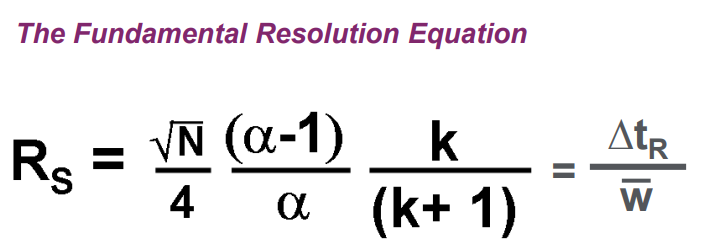Posted by Chrom Tech on 14th Oct 2025
Methods for Changing Peak Resolution in HPLC

Achieving clear separation between closely eluting peaks is one of the most common challenges faced by chromatographers. Optimizing peak resolution in HPLC involves fine-tuning three key factors: retention factor (k), selectivity (α), and column efficiency (N). Understanding how each parameter influences resolution helps you design methods that deliver accurate, reproducible results with sharp, well-defined peaks.

N = Column Efficiency – Column length and particle size
α = Selectivity – Mobile phase and stationary phase
k = Retention Factor – Mobile phase strength
Optimizing Resolution Through Retention Factor
The retention factor (k) represents how long an analyte interacts with the stationary phase. Adjusting the mobile phase composition is the most effective way to control retention. In reversed-phase HPLC, reducing the percentage of organic solvent (such as acetonitrile or methanol) in the mobile phase increases retention, enhancing separation for closely eluting peaks.
Resolution can also be improved by increasing the plate number (N) of the column—achieved by using:
- Longer columns
- Columns packed with smaller particles
- Elevated column temperatures to reduce viscosity and improve mass transfer
When optimizing retention, it’s best to alter one variable at a time—such as switching between organic solvents (acetonitrile, methanol, or tetrahydrofuran)—to observe how selectivity and retention shift between compounds.
Optimizing Resolution Through Selectivity
Selectivity (α) is the most powerful variable for changing resolution in an HPLC method. It’s largely determined by the interaction between the analyte, the mobile phase, and the stationary phase. In reversed-phase chromatography, analytes partition between a polar mobile phase and a non-polar stationary phase—typically resulting in hydrophobic interactions that depend on the analyte’s chemical structure.
For reversed-phase separations:
- More polar analytes elute faster (less retained).
- More hydrophobic analytes (longer alkyl chains or aromatic groups) are retained longer.
For instance, a series of fatty acids such as C12, C14, C16, and C18 will elute in increasing retention order with chain length (C12 least retained, C18 most retained).
When developing a reversed-phase method, start by selecting the appropriate pore size to ensure that analytes can access the stationary phase pores. Then choose the stationary phase that best suits the sample type:
- C18 phase: Ideal for small, hydrophobic molecules.
- C8 or C3 phases: Offer lower retention for very hydrophobic analytes.
- Phenyl or diphenyl phases: Enhance selectivity for aromatic compounds.
Finally, select the mobile phase solvent combination that yields the best separation. Choosing solvents from different regions of the selectivity triangle ensures a greater selectivity difference and optimal separation between analytes.
Optimizing Resolution Through Column Efficiency
Column efficiency (N) reflects how well the column minimizes band broadening, leading to sharper peaks and improved resolution. Efficiency increases with smaller particle sizes, longer column lengths, and optimal flow rates. However, practical limitations such as system backpressure and run time must also be considered.
In theory, very long columns packed with small particles at high temperatures produce maximum resolution. In practice, chromatographers balance speed, resolution, and pressure by selecting shorter columns with sub-2 µm particles and operating at moderately elevated temperatures. This approach achieves high-resolution separations without compromising system stability or analysis time.
For all your chromatography consumables—including columns, solvents, and fittings—Chrom Tech offers expert support and a comprehensive inventory to help you achieve consistent, high-resolution results in every HPLC run.
Frequently Asked Questions About HPLC Peak Resolution
What factors affect peak resolution in HPLC?
Peak resolution depends on three parameters: column efficiency (N), selectivity (α), and retention factor (k). Adjusting column length, stationary phase, and mobile phase composition can significantly enhance separation quality.
How does column particle size affect resolution?
Smaller particle sizes reduce band broadening and improve separation efficiency, resulting in sharper, better-resolved peaks. However, smaller particles also increase system backpressure, requiring UHPLC-capable systems.
Which stationary phase should I choose for my HPLC method?
For general reversed-phase applications, C18 columns are a reliable starting point. For highly hydrophobic compounds, shorter-chain phases like C8 or C3 may be preferred. Aromatic analytes often benefit from phenyl or diphenyl stationary phases.
What’s the best way to improve selectivity between peaks?
Changing the mobile phase solvent or stationary phase type can alter analyte interactions and enhance selectivity. Selecting solvents from different groups on the selectivity triangle offers the greatest improvement.

